Англійська мова (дистанційний курс): Урок 5 з циклу уроків з теми “Food and drinks”
Рекомендації
- Ознайомся з темою та метою уроку;
- уважно прочитай теоретичний матеріал;
- переглянь презентацію, яка містить цікавий додатковий матеріал;
- виконай практичні завдання;
- перевір свої знання за допомогою тестів.
Тема: Іменник. Вживання незлічувальних іменників.
Мета: повторити вивчені лексичні одиниці, познайомитись з новими лексичними одиницями, ознайомитись з правилами вживання незлічувальних іменників, тренувати учнів у вживанні нового граматичного матеріалу, навчитися ставити запитання, практично закріпити вивчені слова, розвивати самостійність, спостережливість, кмітливість, розвивати вміння переносу знань у нову ситуацію, діалогічне мовлення та навички читання, мовну здогадку, пізнавальний інтерес, прищеплювати любов до праці, виховувати почуття ввічливості, свідоме ставлення до навчання.
Словник термінів
Іменник - це частина мови, яка означає предмет і відповідає на питання хто? що?
Теоретичний матеріал

пляшка склянка глечик чашка пакет скляна банка

буханка шматок пакет банка пляшка миска

![]()
![]()
![]()
кілограм плитка, брусок шматок
Практичні вправи
Task Which are the odd ones out in the each line?
|
1. |
tomato |
crisps |
potato |
onion |
|
2. |
egg |
cheese |
salt |
chocolate |
|
3. |
loaf |
bread |
salmon |
sandwich |
|
4. |
onion |
kilo |
spoonful |
cup |
Task . Choose correct answer.

- a can/bottle of cola 2) a kilo/packet of biscuits 3) a jar/carton of milk 4) a slice/kilo of cake
Task 2. Complete the sentences with a lot of, few, little, jar, can, box, packet, glass.
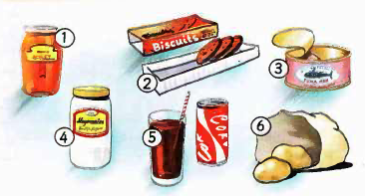
- There is _____ of honey in the _______ .
- There are _______ biscuits in the ______ .
- There is _______ tuna in the ________ .
- There is ________ mayonnaise in the _______ .
- There is ________ Coke in the _______ .
- There are _______ potatoes in the ______ .
Task 3. Fill in the correct words.
-
A
 _____ of bread
_____ of bread
-
A
 ______ of cheese
______ of cheese
-
A
 _____ of crisps
_____ of crisps
-
A
 _______ of milk
_______ of milk
-
A
 ______ of bread
______ of bread
-
A
 _______ of coffee
_______ of coffee
-
A
 _______ of soup
_______ of soup
Task 4 Cross out the odd word.
- A carton of - milk, juice, lemonade
- A packet of - crisps, bread, flour
- A slice of - water, cake, cheese
- A bar of - chocolate, soap, coffee
- A cup of - tea, meat, coffee
Task 5. Match the words to make word-combinations:
1) a bottle a) of honey
2) a glass b) of meat
3) a slice c) of water
4) a loaf d) of tea
5) a cup e) of bread
6) a carton f) of milk
7) a jar g) of sugar
8) a kilo h) of chocolate
9) a jug i) of cola
10) a bar j) of cheese
11) a packet k) of peanuts
12) a piece l) of cheese
13) a can m) of ham
14) a tin n) of fish
Task 6. Match.
|
|
Task 7. Write.

- ____________ 2) ____________ 3) ______________ 4) ______________

- _____________ 6) _____________ 7) ____________ 8) _____________
Task 8. Max’s trolley is missing. Find Max’s trolley.
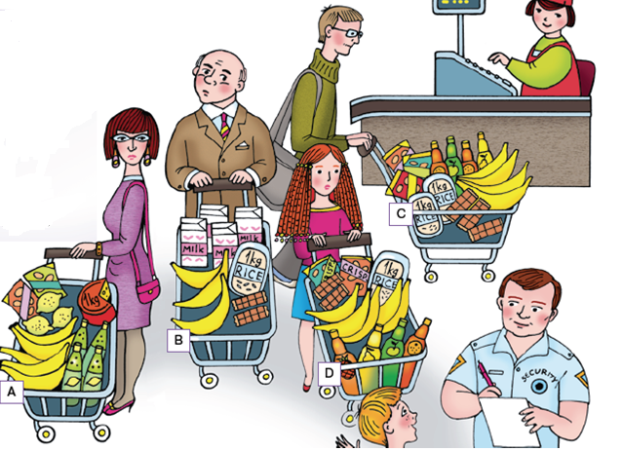
Max’s trolley has got two packets of crisps, three lemons, five bananas, four bottles of lemonade and one kilo of cheese.
Test 5 ( lesson5)
1. Put the letters in the correct order.
- aptkec b) aolf c) ctroan
2. Choose the correct answer.

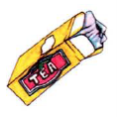

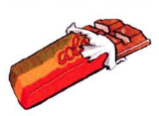
- bottle, bar, packet, can.
- packet, can, bar, bottle.
- bottle, packet, can, bar.
- bottle, can, bar, packet.
3. Label the picture.
1) _______ 2) _______ 3) _____ 4) ________ 5) ________
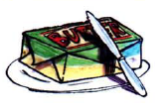
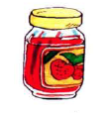


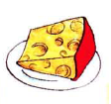
4. Match.
- A cup of a) tuna
- A glass of b) water
- A loaf of c) bread
- A packet of d) cake
- A slice of e) pasta
- A can of f) coffee
5. Fill in the correct word.
- I would like …….. of coffee, please.
- We have got three …….. of cola.
6. Complete with the words.
1) Get me a …….. of coke from the fridge, please.
a) can b) bottle c) packet
2) Would you like a …… of bread with your soup?
a) jar b) bar c) slice
3) Are you hungry? I have a …… of crisps in my bag.
a) loaf b) kilo c) packet
4) There’s a …….. of coffee on the table.
a) bag b) cup c) bottle
7. Choose the odd one out.
1) a carton of milk/yogurt/chicken
2) a packet of meat/spaghetti/biscuits
3) a jar of honey/cola/jam
4) a bottle of lemonade/water/flour
5) a slice of bread/cheese/rice
8. Put the words in the correct order.
a) We b) a carton c) for d) need e) of milk f) cake g) our
9. Complete with the words glass, packet slice, cup, bar, bottle.
Remember to get a 1) _______ of pasta and a 2) _______ of soap, too.
Would you like a 3) ______ of tea?
There’s a 4) ______ of water in the fridge.
You look thirsty. Would you like a 5) _______ of lemonade?
Sorry. There’ only one 6) _________ of bread.
10. Read and match.
|
1) I’m starving. Is there any lamb left? 2) What would you like? 3) Shall I do the washing up? 4) What shall I do with the potato?
|
|
11. Match.
|
1) I have got a packet of 2) We need three bottles 3) Can you buy a kilo of 4) There are two jars
|
|
12. Read the text and complete the sentences.
Obento, a tasty tradition
It’s lunchtime at school and you're heading for the canteen, but what will you have to eat? Will you have a sandwich and an apple, or maybe a hot meal? Things are a little different in Japan. Children open their lunchboxes to find rice shaped like footballs, eggs that look like rabbits or flower-shaped carrots all packed up in an obento!
An obento, or bento, is one of the oldest food traditions in Japan. Basically, it is lunch served in a box. Obento boxes have been part of the Japanese society since the 5th century when people used to take a packed lunch with them to work. Bentos have become very popular since then and you can buy them almost anywhere nowadays at theatres, airports and even at train stations. An obento usually consists of four parts rice, three parts meat or fish (fried or grilled), two parts vegetables (pickled, boiled or steamed) and one part fruit. It should be nourishing and healthy, but it must be appealing too. You often see food shaped like flowers, animals and sometimes even cartoon characters! Mothers take great pride in creating "school-bentos" for their children. Nursery schools have established regulations for obento. Food should be easy to eat with chopsticks or the fingers, portions should be small and it should be pleasing to the eye. It should also include food that the child would not normally eat so that they won't become a fussy eater.
The Japanese have always looked upon the mother as one of the main
influences of a child's success. Taking time to prepare their children's food shows their love for them.
And what happens if a Japanese mum runs out of ideas? There are almost 400 magazines available to get inspired.
- An obento, or bento, is one of the oldest food traditions in …
- You can buy an obento.... …. |
- An obento consists of .... …
- It is important that obentos look…
- Obento portions for nursery schools should be…


про публікацію авторської розробки
Додати розробку
